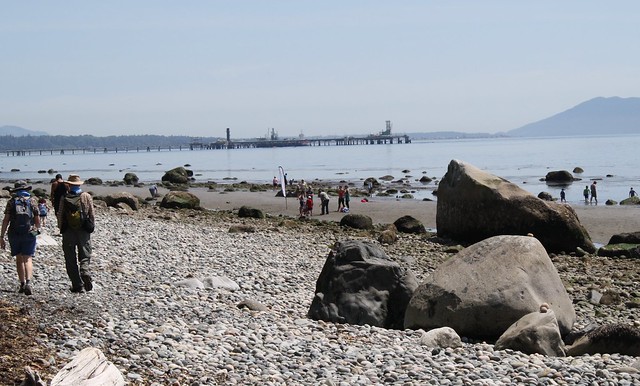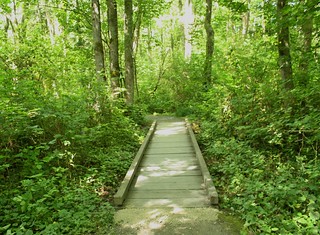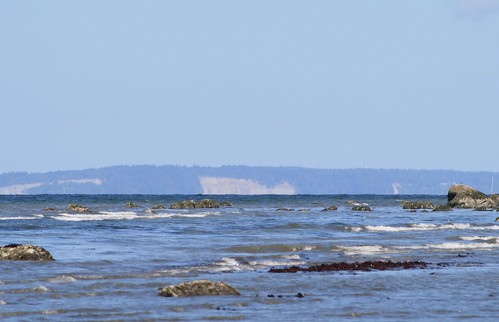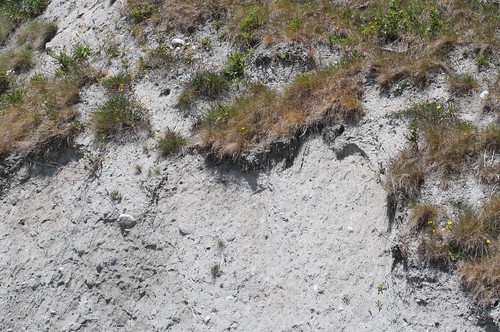This diary may seem a bit disjointed but each part is in fact related and I hope of interest to this group. Each of the components emanates from a beautiful beach and pertains to various environmental and geologic issues currently and historically in play in Whatcom County and Washington State.

Point Whitehorn Marine Reserve Beach
Some items can be seen as hopeful, positive, and far sighted like the State’s aquatic reserve program. Others are worrisome and seen by many as looming disasters waiting to happen such as the potential coal export terminal slated to be situated in this area. And finally, I describe some geology of how our beautiful region, including this beach became what it is today.
Some items can be seen as hopeful, positive, and far sighted like the State’s aquatic reserve program. Others are worrisome and seen by many as looming disasters waiting to happen such as the potential coal export terminal slated to be situated in this area. And finally, I describe some geology of how our beautiful region, including this beach became what it is today.
For many Cherry Point might ring a bell or for some, set off alarms. It is the site where the coal moguls lust to build the largest coal export terminal in the country that would ship coal from Wyoming and Montana to Asia. This proposed Gateway Pacific Terminal is what we local progressives and Native Americans have been protesting now for several years. If this were to be built, it would be adding insult to injury because the Cherry Point Industrial area already is home to two oil refineries and an aluminum plant, each with its own shipping terminal, some of which you can see in the first two photos. We think the fight is going well for several reasons but that is a story in itself.
This industrial area, generically called Cherry Point, is zoned as Heavy Impact Industrial and includes several miles of saltwater beach and significant tidelands at low tide. The area lies about 15 miles northwest of Bellingham and about 10 miles south of the Canadian Border.

Cherry Point Industrial Area, Whatcom County, WA (attribution: NOAA)
Some of the upland area and all of the aquatic area is part of the Cherry Point Aquatic Reserve (including the Point Whitehorn Marine Reserve). This beach area abuts some 100 foot high cliffs. At the top is land purchased by the Whatcom Land Trust with the help of a million dollar grant from the State Department of Ecology from fines levied on Olympic Gas Company for its tragic gas pipeline fire that took the lives of three Bellingham youths. The County Park system maintains the access to the reserve.
Washington State has seven such aquatic reserves in the Puget Sound region, managed by the Department of Natural Resources in conjunction with County and State governments, NGOs, Tribes, and citizens’ groups. Talk about forward looking: Would you believe that they have a 90 year management plan in place to maintain this treasure?
As steward of 2.6 million acres of state-owned aquatic lands, DNR is establishing aquatic reserves throughout the state to protect important native ecosystems. It is an effort to promote the preservation, restoration, and enhancement of state-owned aquatic lands that are of special educational, scientific, or environmental interest.
The Cherry Point Aquatic Reserve Citizen Stewardship Committee conducted intertidal surveys in 2013 and 2014 in the Cherry Point Aquatic Reserve to document beach slope, substrate, and diversity of intertidal animals and plants along four profiles. This is one of many citizen scientist monitoring programs currently ongoing in the area.
To highlight this gem to the public the Citizen Stewardship Committee and the Whatcom Land Trust sponsored an event on a beautiful June day with a minus tide exposing the full beach and tidelands. This event included a guided geology walk on the beach, intertidal zone demonstrations by Marine biologists, an Audubon Society bird spotter with scope, and a plant biologist along the trail for identification of flora. It drew a relatively large crowd with parking lots overflowing and parking as much as a 1/2 mile away. I heard someone say: “this is the most cars that have ever been in this parking lot.”
At the park were some booths with posters and illustrations of the area and handouts including special bandana for the occasion.


Whatcom Trust Bandana Paper Birch Tree
The tour begins at the park trail head with a ¾ mile trail walk along a well groomed trail with bridges over the many wet areas, thick with red cedar, vine maple, and Paper Birch trees. Birch Bay, just around the corner from Point Whitehorn was named by Captain Vancouver after these birch trees that were and are so abundant here.
Lush undergrowth included ferns, Cow Parsnip, Nettles, Red Elderberry, and loads of salmonberries.

Wet land’s bridge along path
Here many of the berries were salmon color (orange), but there were also a number of red (Sockeye?) salmonberries.
The walk through the woods and wet lands takes us to the edge of a bluff overlooking the beach, the San Juan Islands to the southwest, and the Gulf Islands of Georgia Strait to northwest, all of which is now designated the Salish Sea. As an aside, Professor Bert Webber and his wife Sue were the Marine Biologists in attendance. Bert is the person who instigated and was the driving force behind renaming these waters and hence recognizing the common ecosystems of these inland seas as the “Salish Sea.”
On reaching the bluffs the trail descends the 100 foot high cliffs over a number of steep switchbacks and stairs to the beach. We are met on the beach with rocks and cobbles of varying size from 2 to 8 inches, much of which is covered with seaweed following a very large tide differential. Toward the water, we see a nice sandy beach edging into the sea.
From the bottom of the stairs looking south, we see several things. To the left is a long dock leading to a loading pier for large freighters and oil tankers. (see first photo) You can see the superstructure of a tanker over the pier and beyond that is the Phillips 66 refinery. Further to the left, not shown, is the BP oil refinery. These are the termini of the numerous oil trains running through our state and county carrying Bakken crude oil. Further to the South is a similar pier for loading Alcoa- Intalco’s aluminum output.
The general industrial area is zoned by Whatcom County as High Impact Industrial use. Currently working to locate there is SSA Marine that proposes to build a coal shipping terminal to handle the Powder River coal deposits that are currently being shipped just over the border, not 20 miles away into Canada. The proposed terminal would result in up to 18, one and a half mile coal trains each day (9 each way) that have trekked across Montana, Idaho, and Washington State to off load their coal destined for Asian markets.
In addition to the coal fired power plants contributing heavily to greenhouse gases, we worry about the dust from the uncovered coal cars along the way and the residue that would drift and be washed into the sensitive shoreline. The coal dust would not only affect human populations but also the estuarial homes of herring and other forage fish as well as hundreds of other living creatures, all of which are integral components of the shoreline ecosystem.
The community, mainly Bellingham, is well organized against this intrusion as is the Lummi Nation which probably has the upper hand as this terminal would seem to be a violation of their treaty fishing rights that have been sacrosanct since 1855. The counter argument from Chamber of Commerce, SSA Marine, and some locals is that potential job creation trumps all else. However, it is clear that once constructed, there would be only a few full time jobs created. I and others will keep you posted as this saga unfolds over the next months.

Oil Tankers loading at BP’s Dock
Geologic History of Point Whitehorn, Cherry Point, and the Salish sea.
Periodically over the past 1 million years of the Pleistocene epoch, enormous ice sheets accumulated and lumbered down from the north as many as six or seven times, scouring out what was to become Puget Sound. Today’s Sound and the Salish Sea are the products of the last such ice age that retreated about 12 thousand years ago. These enormous ice sheets in this northern region reached up to 8,000 feet deep. These sheets extended as far south as Olympia, the southern end of the Sound where the ice sheet was considerably shallower.
Although there were many affects of these enormous ice sheets such the presence of Puget Sound and the Salish Sea, some of the less obvious remnants are on display at Point Whitehorn as well as other points around the Sound. When the ice sheets developed and moved south from what is now Canada and the Rocky Mountains, they scraped up large quantities of terrain such as rocks and boulders that were in its path and became incorporated into the sheets as they moved south. The cobbles seen on the beach here were probably picked up as the glaciers came down the Fraser River Valley. One clue as to where they came from is that they were already rounded when they got here and apparently having been smoothed by tumbling along the streams and river beds. Another clue identifying these cobbles as erratics is the number of quartzite rocks here. There is no quartzite found in Western Washington or in the Western Cascade Range other than occasional erratics.

Beach cobbles of various origins deposited as glacial till (the tan colored ones are quartzite)
When the glaciers eventually melted they left the rocks and other debris as till deposits hundreds of feet thick. The cliffs above are remnants of that glacial till which continues to slough its load as storms and waves erode it. The cobbles, stones, boulders, clay, and sand tumble down to continue to create the beach we see today. Below you can see the cobbled beach, and sand with large boulders spread about.
In the following photo you can see cobbles still in the cliffs nestled in the dirt and sand, waiting to be released to become more of the beach. This bluff is the glacial till left behind when the glaciers melted.
The glaciers not only brought the till for the hill but also huge boulders that were picked up and/or broken out of mountain formations as they ground their way south from various points in Canada including the Rockies. These large boulders, as well as the cobbles deposited with the melting of the glaciers are referred to as erratics, as they differ in development and composition from their current surroundings. These large chunks of stone were carried from hundreds of miles away and deposited in foreign terrain. It is awe inspiring think that boulders this size were ripped off from mountains and toted along in glaciers.

Beach combing companion in front of a huge erratic
These erratics represent essentially the same processes as I described in previous diaries and as seen in Eastern Washington’s landscapes having been ferried there by giant icebergs during the Ice Age floods.
Below are a couple of erratics with some interesting features.
The large boulder on the left is a Granodiorite (a granitic rock). Of interest are the darker “blobs”, seen in it, technically called “blebs.” These are andesite intrusions that during their development pushed into the granodiorite magma while they were cooling. Also of interest is that right next to this granitic erratic is a totally different boulder from a different origin. This one is of some type of greenstone of altered basaltic origin. So, two erratics, formed by different processes and picked up at different locales were deposited side by side on this beach.
Looking north across the strait of Georgia, we see bluffs similar to those here. These bluffs are on what is now Point Roberts which is a tongue of land that juts south from Canada crossing the 49th parallel and is thus part of the US. You can only access it from the US by boat or by crossing the border twice, north into Canada and then south into the US.

Glacial till bluffs at Point Roberts, about 10 miles across the Strait of Georgia, NW of Point Whitehorn
These and other bluffs throughout the San Juan and the Canadian Gulf Islands are continuations of the same sediment deposit seen at Point Whitehorn. The cliffs and islands have been eroded over thousands of years by various geologic processes. For example as the ice sheet melted and receded, this whole area was for a while an inland freshwater Lake (Glacial Lake Russell). Pent up ice dams between this lake and the Pacific Ocean eventually broke allowing saltwater to enter via the Strait of Juan de Fuca, creating the Salish Sea much as it is today.

Sucia (midground left) and Patos (midground right) Islands looking SW from Whitehorn
Sea and shore life abound here within the tidal zone and beyond with herring (which are in decline) and are the primary reason for the Preserve status of this bio-rich area. Even with the major industry only a stone’s throw away, we find a few surviving sea stars and a plethora of anemones seen below. You can imagine what an oil spill and coal dust here would do. Currently these beaches are regularly monitored with ongoing studies using Citizen Scientists as data collectors.















Hello Moose folks,
Here is a post based on our area of northwest Washington State and some of its environmental happenings, some good and some not so good. I hope you enjoy the photos and the commentary.
Thanks RonK! The grand kids are enjoying their photo trips with you :)
Thanks, RonK! There is a lot to digest; I will finish reading in the morning.
Thanks JanF.